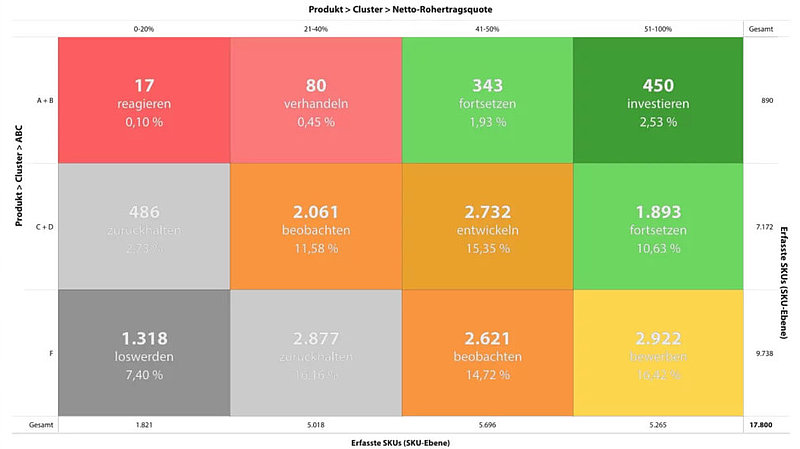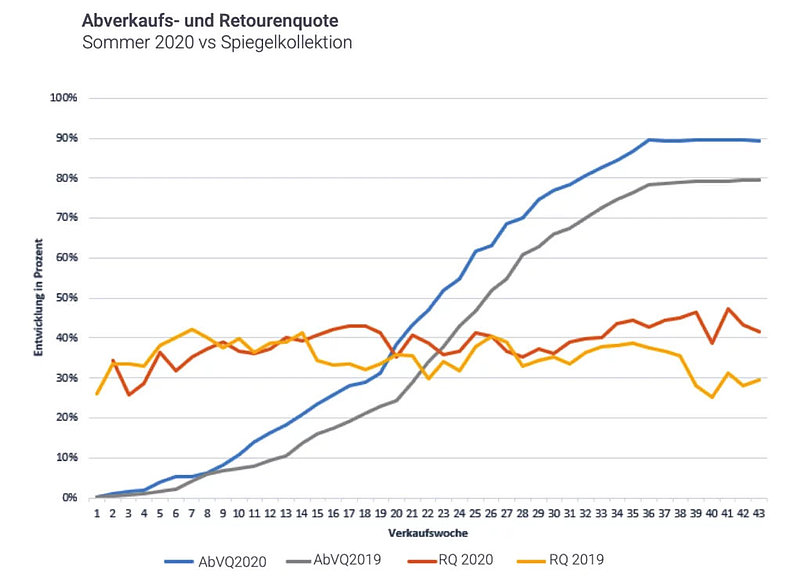Companies face the challenge of remaining competitive and adapting to a constantly changing environment: optimized processes, new products and improved services. What you need for this is a deep understanding of the customer, a detailed analysis of the market situation and a comprehensive overview of your business processes.
A huge amount of data is available to companies to make business decisions. A lot of data means a lot of information, but only those who have a concrete strategy for using, structuring, analyzing, and visualizing this amount of data will gain knowledge from it and be able to derive recommendations for action.
A Valuable Asset: The Combination of Market and Company Data
A high degree of market transparency reduces the risk of faulty decisions. Whoever knows the competitor’s prices, promotions and stock availability, and can assess their ratings and relevance, has a clear advantage.
The same applies to your own company. Here, too, complete omni-channel transparency is necessary for a holistic business view. Only those who know their sales and turnover figures, their product range, their customers and their behavior can make sound decisions.
If companies combine these internal insights with a further dimension, the external market data, they receive an even more extensive, and the best possible, basis for making data-driven decisions: more conversion, more sales, the perfect price and product strategy and, for sure, an advantage over the competition.
How can Retailers, Manufacturers and Brands Benefit Specifically?
An example: assortment and product optimization for retailers
Who is my competition? On which channels are they active and how does the price and product range control take place there? Is there a specific discount structure? And which products are currently in greater demand? Where is the potential? Questions that have a very fundamental and strategic relevance for retailers to get an overview of the industry.
Interesting analyses can be derived from this market information, which can be used in comparison with your own internal data, for example, for product range optimization. The retailer must know the performance (returns, cancellations, goods used, etc.) of their products, down to the contribution margin level, to identify top performers and unprofitable items. It is only possible to invest properly when the retailer knows how profitable their products are. Where the margins are high, investments are worthwhile – otherwise companies are giving away money. (The exception here is the temporary acceptance of a lack of profitability for the purpose of increasing the product range.)

Once a retailer has gained an overview of the market and the business performance, measures for optimization can be found: Which products are important unique selling points that differentiate me from the competition? Are there any poor performers for whom there is a good reason that no competitor has them in their product range? Which brands/categories/colors/styles etc. perform particularly well and should therefore be included in the product range? Decisions and specific measures can be made deliberately by the retailer and based on a comprehensive database.
An Example: Market and Competitive Analysis for Brands and Manufacturers
For brands and manufacturers who sell their goods via direct sales, exclusive sales or retail, it is primarily important to know what is happening in the individual sales channels. Which retailers and how are the products sold, which ones perform well and how do price trends, stability and product cycles show up on the market? With this knowledge, you can react quickly and dynamically to changes and draw conclusions about which retailers are the right trading partners for you.
Ideally, this information is analyzed with the performance, return rate and profitability of the products and collections via the company’s own sales channels. Brands and manufacturers understand the dynamics of their product portfolio (seasons, fluctuations, returns, discount effects, etc.) and can specifically perfect demand planning and control for the product range of the coming season by eliminating low-margin products and focusing on low-returners.

A sales analysis can be an example of this. Companies can find out: at what point in time which products from the collection should be offered via which sales channel with which price tag, to sell as much as possible of the collection on the one hand, and to achieve the maximum profit margin on the other. Analyses like these boost sales, increase profitability, minimize returns and ensure rapid inventory turnover. The targeted selection and forward-looking management of the product range is a critical success factor for brands and manufacturers.
But How do I Get to my Data?
Software solutions such as the XPLN suite provide retailers and brands with all the information they need from the market and thus offer comprehensive price and competition transparency.
To achieve complete transparency over the internal business view – sales and turnover figures, product range, customers, and their behavior – a structured data analysis is required within the company. The challenge: although the relevant data is often available in the company, it is locked in data silos and not accessible across departments. This means that existing data potentials are often not used.
The key to success therefore lies in a comprehensive database that brings together the relevant data from the various sources, systems and applications. Business Intelligence solutions such as minubo can help with this. Our SaaS solution was specially developed for retail companies and brands and it enables data from all relevant systems (POS, ERP, online, store, etc.) to be integrated into a holistic, consolidated database. The Business Intelligence solution thus supports companies in making their data fully usable, carrying out detailed analyses down to the individual customer, individual product, individual order, and thus being able to make better and faster decisions based on data.
About minubo – Smart Decisions. Every Day. For Everyone.
The Hamburg-based company is convinced that successful retail must be data-driven. minubo has many years of experience from the industry, operational excellence and extensive expertise from 150+ implemented Business Intelligence projects in retail, e-commerce and omni-channel. Employees from all areas are able to make their daily decisions better and faster based on data. The Business Intelligence solution comprises a full BI stack as a plug & play concept – from integrations across processing and modelling to a wide range of tools. Also it provides its customers with a short-cut to a data-driven decision culture by covering all analytical areas: easy reporting, flexible business analytics as well as operational insights including intelligent action recommendations.
Act faster, more targeted, data-driven – with minubo Commerce Intelligence. BI for Retail.
